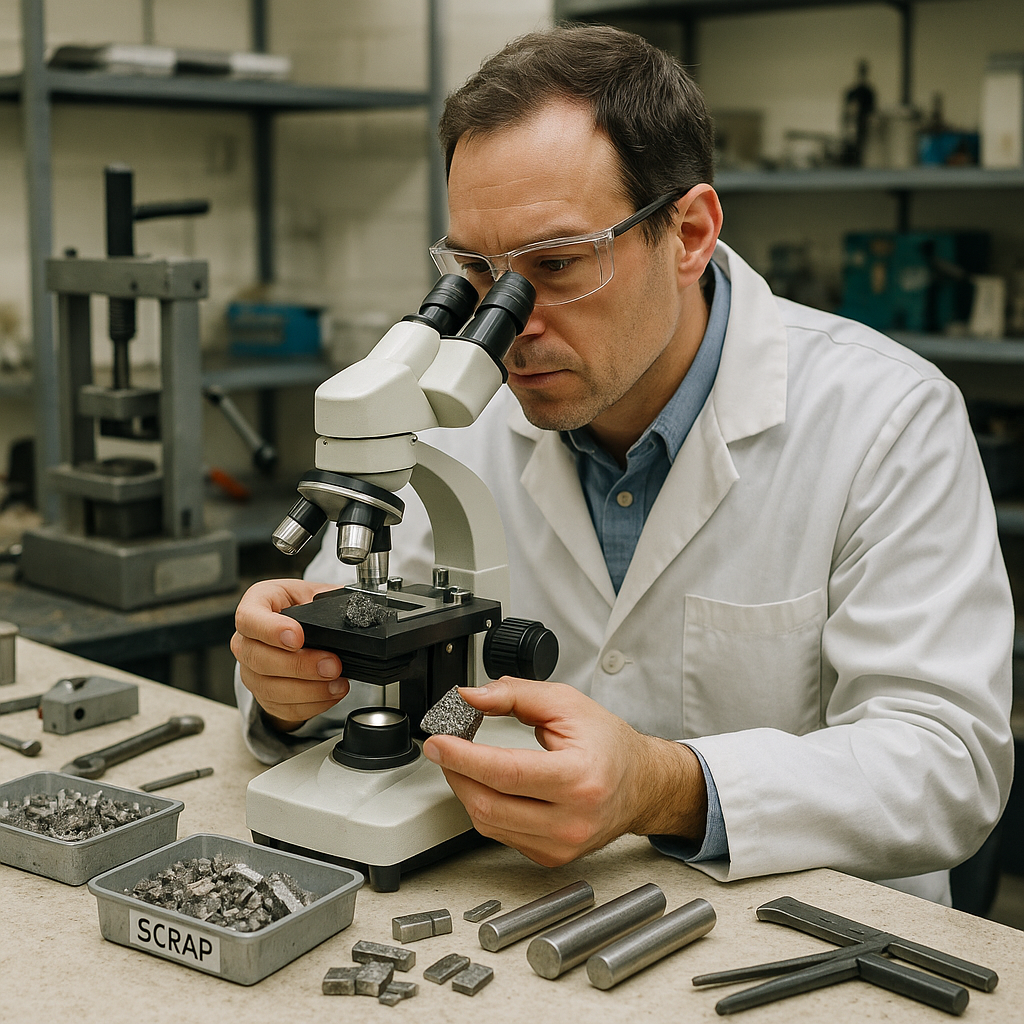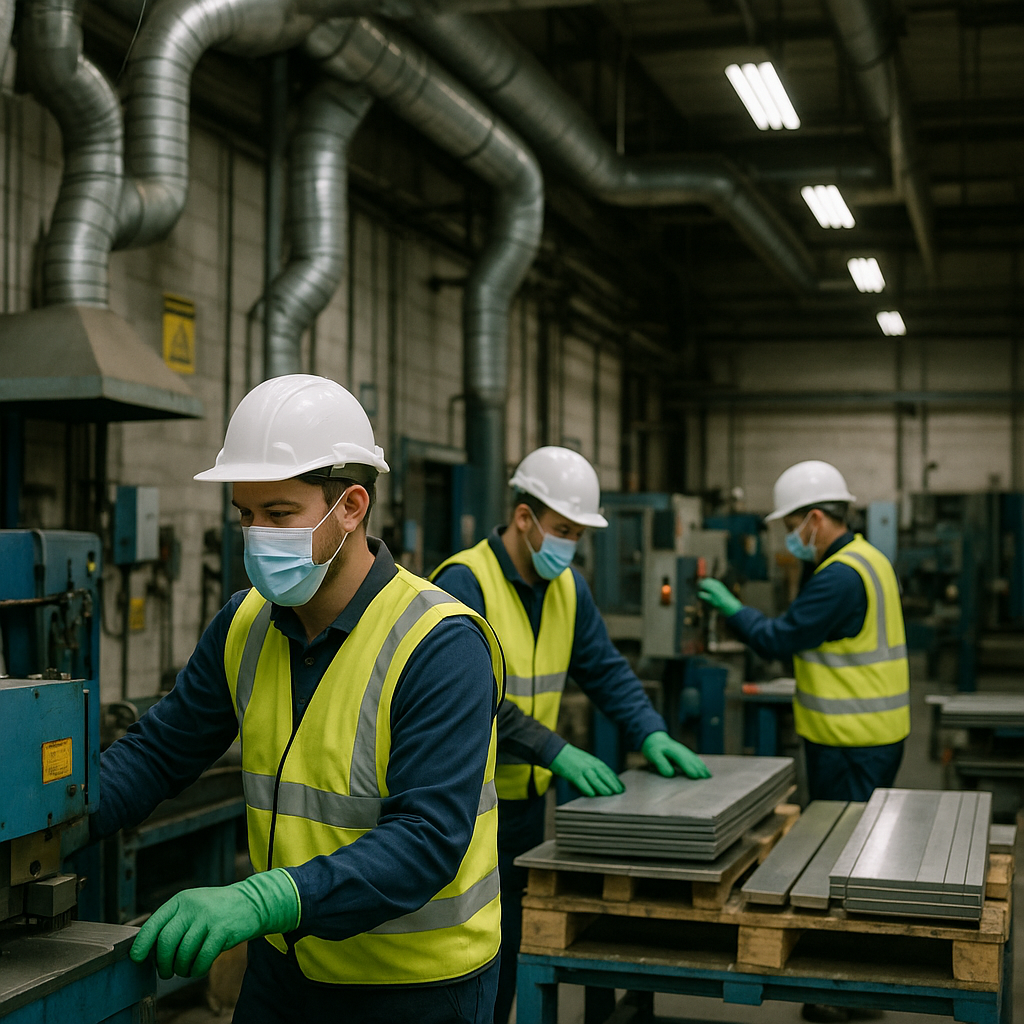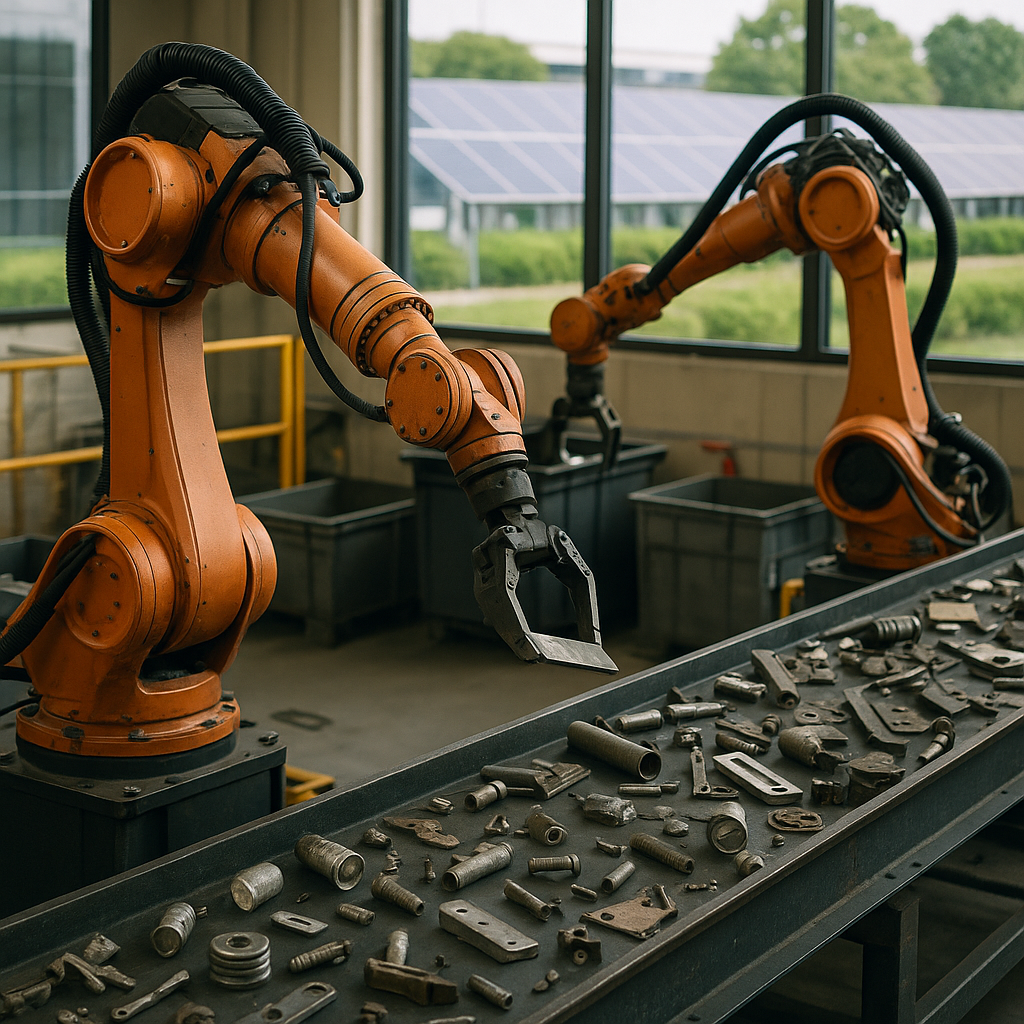5901 Botham Jean Blvd, Dallas, TX 75215
What Are Specialty Metals and Their Environmental Impact?
June 18, 2025Every smartphone, solar panel, and electric vehicle relies on a foundation of specialty metals. These critical materials—including titanium, tungsten, and rare earth elements—form the backbone of modern technology. Their unique properties enable everything from renewable energy systems to advanced medical devices.
The global shift to clean energy is rapidly increasing demand for these metals. A typical electric vehicle requires six times the mineral inputs of a conventional car. Wind turbines need up to nine times more mineral resources than gas-fired power plants with similar capacity.
Yet this technological progress has a significant environmental cost. Mining operations for specialty metals often involve extensive land disruption, water pollution, and high energy consumption. Processing these materials requires intensive chemical treatments that generate toxic waste. This creates a challenging paradox: the very materials enabling our green transition carry substantial ecological footprints.
How does specialty metal recycling reduce environmental impact?
Specialty metal recycling plays a crucial role in environmental conservation. By reclaiming and reprocessing materials like rare earth elements, precious metals, and high-performance alloys, the need for environmentally harmful mining operations is greatly reduced. The benefits extend beyond waste reduction, leading to a cascade of positive environmental effects.
Reducing harmful mining practices
Mining for virgin metals often results in significant environmental damage. Open-pit mines devastate local habitats, contaminate water sources, and release toxic chemicals into ecosystems. By meeting industrial demands through recycled materials, we can minimize the expansion of these extraction operations.
Conserving biodiversity is one of recycling’s key benefits. Natural habitats remain undisturbed when we reduce the need for new mining sites. This protection extends to water resources that would otherwise face contamination from mining runoff and processing chemicals.
Specialty metals like titanium, tungsten, and rare earth elements require particularly intensive extraction processes. Recycling them delivers greater environmental benefits compared to more common metals.
Significant energy savings and emissions reduction
The energy savings from specialty metal recycling are substantial. Recycling aluminum requires up to 95% less energy than producing it from raw bauxite ore, resulting in a significant reduction in carbon emissions – nearly 9 tons of CO2 emissions are prevented for every ton of aluminum recycled.
Similar benefits apply to various specialty metals. Recycling copper saves up to 85% of the energy compared to producing new copper from ore. Steel recycling reduces energy use by approximately 60%. These figures represent significant reductions in industrial energy consumption and greenhouse gas output.
The environmental impact multiplies when considering the millions of tons of metals recycled annually worldwide. Industries embracing recycled specialty metals significantly lower their carbon footprint without compromising material quality or performance.
| Metal | Energy Savings (%) | CO2 Emission Reduction (%) |
|---|---|---|
| Aluminum | 95% | 92% |
| Steel | 60% | 58% |
| Copper | 85% | 65% |
Resource conservation through circular economy
Specialty metal recycling exemplifies circular economy principles. Instead of following the traditional take-make-dispose linear model, recycling creates a closed loop where materials maintain their value and utility through multiple life cycles.
This approach conserves finite metal reserves. Every ton of metal recycled is a ton that doesn’t need to be extracted from the earth, ensuring availability for future generations and critical technologies.
The circular model extends beyond conserving metal reserves. It creates systems that minimize waste at every stage of production and consumption, addressing multiple environmental challenges simultaneously.
Innovative recycling approaches
Advanced technologies continue to enhance the environmental benefits of specialty metal recycling. Hydrometallurgy uses aqueous solutions to extract and recover metals with high selectivity and lower energy requirements than traditional methods, achieving recovery rates of up to 99% for valuable metals like cobalt and lithium from spent batteries.
Pyrometallurgical processes utilize high temperatures to efficiently extract and purify metals from mixed scrap sources. While energy-intensive, these methods can process large volumes quickly and handle materials with organic contaminants.
Electrorefining achieves ultra-high metal purity through electrochemical processes, producing metals with 99.99% purity for industries like electronics while using less energy than primary production.
X-ray fluorescence, eddy current separation, and laser-induced breakdown spectroscopy allow for precise identification and segregation of different specialty metals from complex waste streams. These sorting technologies maximize recovery rates and material purity.
Overcoming recycling challenges
Despite its benefits, specialty metal recycling faces several challenges. The complex, multi-material nature of many modern products makes complete separation difficult. A smartphone may contain over 60 different elements, requiring sophisticated processing to recover effectively.
Design for recyclability has emerged as a solution. Manufacturers increasingly consider end-of-life disassembly during product development, creating goods that can be more efficiently recycled.
Another hurdle involves the lack of standardized processes for handling certain specialty metals, particularly those used in emerging technologies. As demand for materials like lithium, cobalt, and rare earth elements grows, developing cost-effective recycling methods becomes increasingly urgent.
Collaboration between industry, academia, and policymakers drives innovation in this field. Investment in research and supportive regulations help unlock the full environmental potential of specialty metal recycling.
What are the challenges in specialty metal recycling?

Specialty metal recycling faces significant hurdles despite its environmental and economic benefits. The industry must overcome complex technical, economic, and logistical challenges to reach its full potential. These obstacles require innovative solutions and collaborative approaches.
Complex Multi-Material Products
Today’s high-tech devices contain a mix of materials that complicate recycling efforts. Modern smartphones, for instance, incorporate over 60 different elements in intricate arrangements. This complexity makes complete separation and recovery extremely difficult.
Electric vehicles present another challenge with their battery systems containing lithium, cobalt, and other specialty metals embedded within multi-layered structures. The interconnected nature of these components often requires specialized disassembly techniques that current recycling infrastructure isn’t fully equipped to handle.
Consumer electronics like laptops and tablets also pose challenges due to their miniaturized components and proprietary designs. Manufacturers rarely prioritize end-of-life recyclability, resulting in devices that are difficult to dismantle efficiently.
Standardization Gaps for Emerging Technologies
As new technologies emerge, recycling processes struggle to keep pace. The lack of standardized methods for handling certain specialty metals has become increasingly problematic. This is especially true for materials used in renewable energy infrastructure and advanced electronics.
The growing demand for lithium, cobalt, and rare earth elements in clean energy technologies has outpaced the development of effective recycling protocols. Each manufacturer might use slightly different material compositions, further complicating standardization efforts.
Without established processes, recyclers must develop custom approaches for each material stream. This inefficiency drives up costs and creates inconsistent recovery rates across the industry. Standardization would enable more predictable outcomes and better economics.
Substantial Investment Requirements
Implementing advanced recycling technologies requires significant capital investment. Many recycling facilities face financial constraints when trying to upgrade their capabilities to handle specialty metals effectively. The sophisticated equipment needed for precise sorting and processing comes with high price tags.
X-ray fluorescence (XRF) spectroscopy systems, which can accurately identify metal compositions, represent just one example of the expensive technologies needed. Similarly, hydrometallurgical and pyrometallurgical processing equipment for metal extraction and purification requires substantial investment.
While these investments can yield long-term benefits, they present short-term financial hurdles for many recyclers. Smaller operations particularly struggle to finance these technological upgrades, creating disparities in the industry’s capability to process specialty metals.
Market Volatility and Economic Challenges
Price fluctuations in the specialty metals market create significant uncertainties for recyclers. Factors like geopolitical tensions, supply chain disruptions, and changing demand patterns contribute to unpredictable market conditions.
This volatility makes it difficult for recycling operations to forecast revenue and plan long-term investments. When prices for certain metals drop suddenly, previously profitable recycling activities may become economically unfeasible.
The economics of specialty metal recycling are further complicated by the relatively small volumes of some materials present in consumer products. The cost of extracting tiny amounts of precious metals from complex devices sometimes exceeds the market value of the recovered materials.
Transportation and Logistics Barriers
The collection and transportation of end-of-life products containing specialty metals present significant logistical challenges. Unlike common metals, which might be available in large quantities at single locations, specialty metals are often dispersed across countless consumer devices.
Creating efficient collection networks for these materials requires coordination between consumers, manufacturers, retailers, and recyclers. The geographic distribution of these stakeholders adds complexity to the logistics equation.
Storage also presents challenges due to safety considerations. Some specialty metals and their compounds may pose environmental or health risks if improperly handled or stored. This necessitates specialized storage facilities with appropriate safety measures, adding another layer of operational complexity.
Innovations Addressing These Challenges
Despite these obstacles, promising innovations are emerging to tackle specialty metal recycling challenges. Advanced sorting technologies using artificial intelligence and machine learning can identify and separate materials with unprecedented accuracy. These systems can process mixed waste streams more efficiently than traditional methods.
Research into novel chemical processes is also yielding results. New hydrometallurgical techniques can selectively extract valuable metals from complex mixtures with reduced environmental impact compared to conventional methods. These processes aim to maximize recovery while minimizing chemical usage and waste generation.
Collaborative initiatives between manufacturers and recyclers are addressing design-for-recyclability issues. When products are designed with end-of-life considerations in mind, the recycling process becomes significantly more efficient. Removable batteries, modular components, and standardized material usage all contribute to improved recyclability.
| Challenge | Potential Solution |
|---|---|
| Complex Multi-Material Products | Design for recyclability to ease disassembly |
| Standardization Gaps for Emerging Technologies | Develop industry-wide recycling standards |
| Substantial Investment Requirements | Collaborative funding for advanced technologies |
| Market Volatility and Economic Challenges | Create stable market conditions through policy support |
| Transportation and Logistics Barriers | Develop efficient collection networks |
Industry collaboration and research partnerships are proving essential to overcome these challenges. By sharing knowledge, resources, and technologies, stakeholders throughout the value chain can develop more effective approaches to specialty metal recycling. The future of this industry depends on continued innovation and adaptation to evolving material streams and technologies.
How are industries addressing the environmental impact of specialty metals?

Industries worldwide are adopting innovative strategies to reduce the environmental impact of specialty metals. The rising demand for high-tech devices and clean energy technologies has made these materials essential, yet their extraction and processing often have significant environmental consequences. Forward-thinking companies are pioneering sustainable solutions that balance industrial needs with environmental protection.
Design for recyclability has become a key strategy in mitigating the environmental impact of specialty metals. By considering end-of-life disassembly during product development, manufacturers create goods that are easier to recycle efficiently. This approach is particularly valuable for electronics containing complex combinations of specialty metals like rare earth elements.
Research and development efforts are transforming recovery techniques for these critical materials. Through technological innovations, companies are achieving higher recovery rates while using fewer resources. For example, hydrometallurgical processes can now recover up to 99% of cobalt and lithium from spent batteries.
Innovative Recycling Technologies
Advanced technologies are revolutionizing how industries recover and process specialty metals. These innovations focus on maximizing recovery while minimizing environmental impact. X-ray fluorescence, eddy current separation, and laser-induced breakdown spectroscopy allow for precise identification and segregation of valuable materials from complex waste streams.
Selective mining techniques represent another important advancement. These methods focus on extracting only high-quality ores, reducing waste and minimizing disturbance to surrounding ecosystems. This approach ensures that critical materials are obtained efficiently with less environmental damage.
Circular economy initiatives are gaining traction across industrial sectors. These programs move beyond traditional recycling to create closed-loop systems where materials maintain their value indefinitely. Key elements include:
- Metal and mineral recycling programs targeting precious and industrial metals
- Product life extension through repair, refurbishment, and remanufacturing
- Collaborative design partnerships between mining companies and manufacturers
- Closed-loop water recycling systems to reduce freshwater consumption
Industry-Led Sustainability Efforts
Beyond recycling, industries are implementing broader sustainability initiatives. Energy efficiency improvements are a major focus, with many companies transitioning to renewable energy sources. This shift significantly reduces carbon emissions associated with specialty metal processing.
Water conservation has become a priority in regions facing scarcity challenges. Mining and processing facilities now implement sophisticated water management systems that treat and reuse process water, dramatically reducing freshwater consumption and preventing contaminated wastewater from polluting local ecosystems.
Carbon capture technologies are being deployed at processing facilities to reduce greenhouse gas emissions. These systems prevent harmful gases from entering the atmosphere, contributing to climate stabilization efforts. The technology complements other sustainability initiatives like renewable energy adoption.
Supply chain transparency initiatives help companies and consumers make informed decisions about material sources. These programs track specialty metals from extraction through processing and manufacturing, encouraging responsible sourcing practices throughout the industry.
Regulatory Frameworks and Industry Standards
Supportive regulations have accelerated sustainability adoption across the specialty metals sector. Governments worldwide have implemented policies promoting responsible resource management, ranging from recycling mandates to financial incentives for sustainable practices.
International standards provide consistent benchmarks for environmental performance. Organizations like the International Organization for Standardization (ISO) have developed specific guidelines for the metals industry, ensuring sustainability claims are verified through transparent metrics.
Public-private partnerships have proven effective in addressing complex sustainability challenges. These collaborations bring together government agencies, research institutions, and private companies, pooling resources and expertise to accelerate innovation in specialty metal sustainability.
Consumer pressure continues to drive industry transformation. As awareness of environmental issues grows, customers increasingly demand responsibly sourced materials. This market force has prompted companies throughout the supply chain to improve their practices and communication about sustainability efforts.
The economic benefits of sustainable practices are becoming increasingly apparent. Energy efficiency improvements and waste reduction directly lower operational costs, while reputation enhancement and market differentiation create new business opportunities. These financial incentives reinforce the environmental case for sustainable specialty metal management.
| Technique | Environmental Impact |
| Traditional Mining | High carbon emissions, energy consumption, water pollution, habitat destruction |
| Bioleaching | Lower energy use, fewer emissions, reduced toxic by-products |
| Hydrometallurgy | Less energy-intensive, fewer greenhouse gas emissions |
| Recycling | Significant energy savings, reduced emissions, conserves resources |
Through these combined approaches, industries are making significant progress in reducing the environmental impact of specialty metals. The transition toward more sustainable practices ensures these valuable materials can continue supporting technological advancement without compromising environmental health.
What does the future hold for specialty metals and sustainability?

The landscape for specialty metals is evolving rapidly as sustainability becomes central to industry practices. Advanced recycling technologies now allow for more efficient recovery of rare and valuable metals from complex products, creating a robust circular economy where materials maintain their value indefinitely.
Responsible sourcing practices are gaining momentum across supply chains. Companies increasingly implement transparent tracking systems to verify that metals come from environmentally and socially responsible sources. These developments reduce the environmental footprint of specialty metals while ensuring ethical production standards.
For businesses and municipalities looking to improve recycling practices and contribute to this sustainable future, contact Okon Recycling at 214-717-4083. Our expertise in specialty metal recycling can help you implement effective waste management solutions while supporting circular economy principles.
